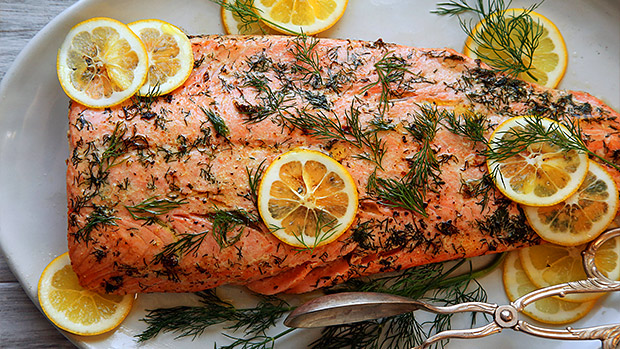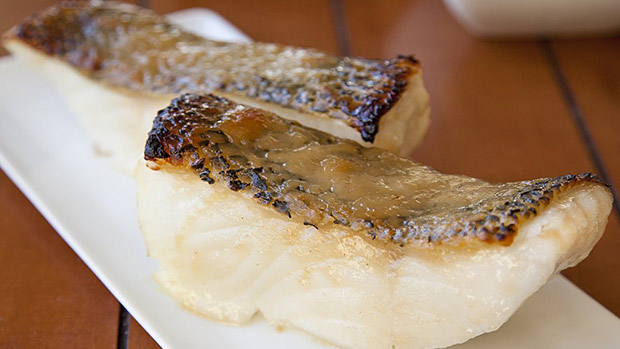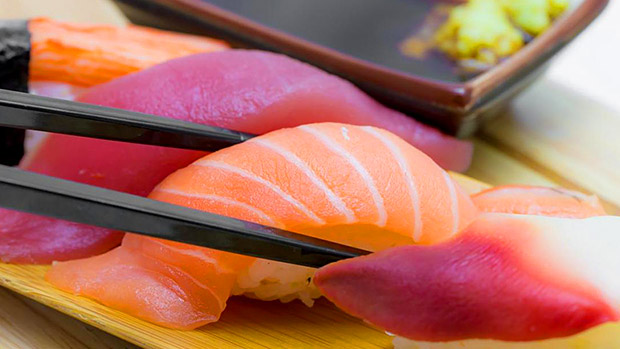Most food marketing is based on varying degrees of deception, but the seafood industry seems to have more than its fair share of seaworthy scoundrels. Some retailers or restaurateurs propagate white lies, while others dispense more serious, "I oughtta' slap you on the side of the head with a haddock" lies. Others merely practice lies of omission.
Here's a short list of my "favorite" seafood lies, from most egregious to least egregious.
The sushi industry is rife with fraud, but it's easy to make sure you're getting what you ordered, and more importantly, what you paid for. Simply scrape a tissue sample from the fish sample in question. Then subject it to a polymerase chain reaction and locate at least 16 specific DNA loci to create a DNA profile. Presto!
Okay, maybe it's not so simple. Too bad, because according a study by the Oceana group a few years ago, up to 74% of all sushi isn't what the restaurant claims it is and substituted varieties are almost universally cheaper than the fish they're replacing.
The problem is, we're so removed from the sea, so incapable of identifying a fish species, that we'd probably identify SpongeBob SquarePants as a flounder. Even so, most of the time we see fish, it's already been filleted, and particularly in the case of white fish, almost indistinguishable from any other fish whose meat is white.
Take for instance "white tuna," which is often used in rolls, and less often, substituted for albacore tuna. The fish isn't tuna, but generally escolar, which is called the "Ex-Lax" fish for the anal leakage it causes. Other fish like cod, halibut, flounder, and grouper are also faked, but the poster child of mislabeled fish is red snapper.
Fraud among sea merchants is so high with this particular fish that a lot of good restaurants won't even bother with it.
I've singled out sushi restaurants here, but the same Oceana group that said 74% of all sushi is mislabeled also determined that 34% of all restaurant food is mislabeled, too. Take for instance sea bass, presumably caught somewhere off the coast of California. Good luck, because there are all kinds of fishes that get passed off as sea bass, including the butterfly perch, the pink maomao, the potato cod, the dusky grouper, the dogtooth grouper, and the toadstool grouper.
The difference in taste might not be substantial, but the hit to your wallet might be. No one wants to pay for (and eat) the piscine equivalent of rat when ordering sirloin.

If you bought a package of allegedly fresh salmon in any month but June, July, and maybe part of August, it's not wild, Pacific salmon. Instead, it's probably farm raised Coho, King, or Atlantic salmon because nearly all Pacific salmon are caught during the summer months, and it can't be farm raised.
This is critical because wild salmon eat their nature-intended diet and develop their pink or reddish color naturally, which indicates they're chock-full of the healthful omega-3 fatty acids we humans covet. This isn't the case with farm-raised salmon. They're fed a diet of fishmeal and grain, which makes them naturally lower in omega-3 fatty acids.
Another result of their unnatural diet is their color; the flesh has the grayish hue of old Jockey shorts. To remedy this, fish farmers give the fish artificial colorants.
Furthermore, farm-raised Atlantic salmon, in particular, are plagued by sea lice – tiny parasites that feed on skin, mucus, and blood. This makes fish farmers resort to chemical remedies that are harmful to sea lice and apparently humans, too.
If you want to eat the good stuff, buy Pacific salmon during the summer months. Otherwise, stock up on canned Pacific salmon and find a good recipe for salmon patties. You might also look for fish labeled Alaskan, because salmon farming is illegal in Alaska, regardless of season.

You'd probably think twice about ordering something called "Patagonian Toothfish" off a menu. The seafood business was cognizant of that fact, so they just gave the unfortunately named fish the much more gentile name of "Chilean sea bass" instead.
It worked so well, that Patagonian toothfish has now become relatively scarce, causing the seafood business to substitute Antarctic toothfish for Patagonian toothfish.
It probably doesn't matter much, taste-wise, but chances are you're paying top dollar for sea bass when you're getting some other, should-be-cheaper, fish.
Other fishes have also had their names changed to make them more appealing. Slimeheads, named that way because of the mucus-filled canals on their faces, are now known as "orange roughy." Dolphinfish are currently called Mahi Mahi, because there was too much of a chance that people would mistakenly assume their dinner fare was an escapee from SeaWorld.

Okay, this one isn't so much deceitful as it is distasteful, but purveyors of seafood sure as hell don't advertise it. You might even know this one but just don't like to think about it. Anyhow, the oysters that you scoop out of their shelves are alive – at least until you crush them with your molars or immerse them in scalding stomach acids.
Of course, if it makes you feel any better, it's possible that the mere action of separating the shell from the meat kills it because its heart is right next to the bottom adductor muscle that you slice to open the shell.
Still, eating them alive is infinitely preferable to eating dead ones as they're more prone to harboring types of bacteria that could make you knock on the door of, or even take up permanent residence in, Davy Jones' locker. Of course, even vibrantly alive ones could harbor vibrio bacteria, which can also lead to severe illness or death.
The safest way to eat them is fully cooked.





